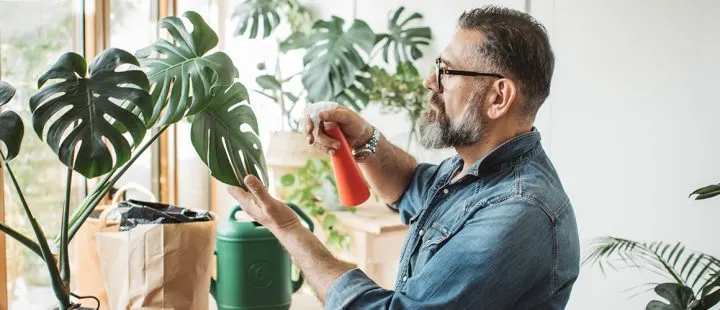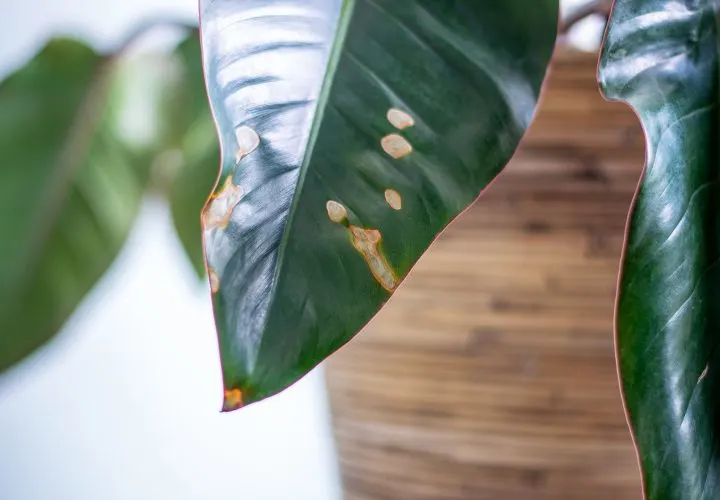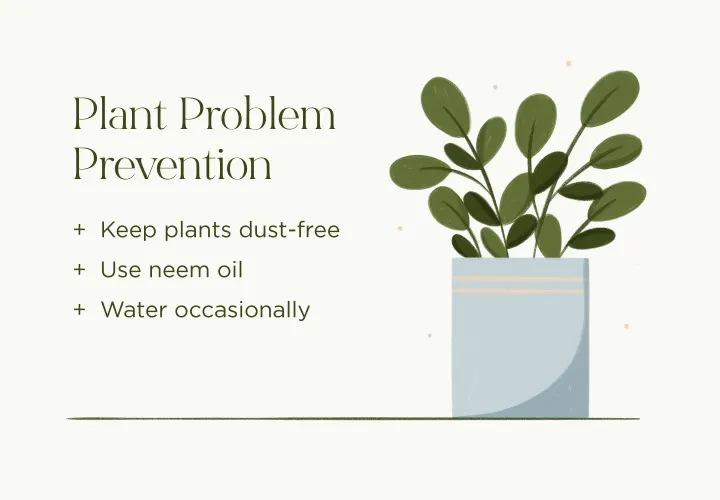June 11, 2021
15 Common Indoor Plant Problems: Treatment, Prevention and Care Tips
Keeping your houseplant happy and healthy can be a breeze in the right conditions, but that doesn’t mean you won’t find yourself experiencing a few plant problems along the way. From pests to diseases to environmental factors, there’s a lot to consider when taking in a new plant.
Check out some of the most common problems below so you can ensure your plant is getting the best care possible.
Common Plant Pests
In order to effectively treat a pest infestation on your houseplant, you’ll need to properly identify the insect. Depending on what developmental stage the pest is at will determine what kind of treatment you need to use. If detected early enough when the insects are still in their larvae stage, removal should be an easy and simple process.
1. Aphids
These tiny insects are extremely common and usually found on the undersides of leaves or at the tip of the plant. If they’ve made your plant their long-term home, you may begin to see feeding damage. This usually includes stunted plant growth, smaller leaves and distorted foliage.
Aphid Solution:
Something as simple as a splash of water can remove the insects, but if you want a more immediate solution, you can opt for an indoor insecticide spray from your local gardening store.
2. Fungus Gnats
If your plant is experiencing root issues, you may have a fungus gnat problem. These little guys like to feed on plant roots and decaying organic material in the soil, which can affect the growth and overall well-being of your plant.
Gnat Solution:
There are several options available when it comes to gnat removal. Spraying the plant with soap and water is a simple household fix, or you can opt to get yellow sticky traps from the store. Or, if you have spare potatoes lying around, cut them up and place the pieces in the soil — the gnats will be drawn to them!
3. Spider Mites
These guys are actually considered arachnids, not insects, and are very hard to see. If you want to check your plant, grab a piece of white paper and shake a leaf onto it — you’ll soon see red and brown dots crawling on the sheet of paper. Spider mites like to hang on the underside of leaves and damage usually occurs from the webbing produced on foliage and stems. As a result, your plant will produce distorted yellow foliage.
Spider Mite Solution:
Letting dish soap sit on the plant for a couple hours can help remove spider mites, but you can also choose a harsher solution like rubbing alcohol. Soak a few cotton balls in rubbing alcohol and wipe it on the foliage. After a few hours, rinse the layer with water.
4. Whiteflies
These gnat-like insects are soft-bodied and usually found in a light yellow or white color. Despite their name, they are not a type of fly, but do in fact have wings and are capable of flying. These pests like to feed on the sap in plants or on the leaves, which causes them to turn yellow and sometimes even white.
Whitefly Solution:
Choosing a less toxic treatment for whiteflies will do the job just fine. Some options include neem oil, insecticidal soap or petroleum-based oils. Spray one of these solutions onto the affected areas and repeat as necessary.
5. Thrips
These insects are almost impossible to see with the naked eye. They tend to be light tan to dark brown in color and like to feed on foliage and flowers. They pierce the plant with their mandible and suck up the juices that seep from the wound. This can cause the plant to become distorted and discolored over time.
Thrip Solution:
If you can, prune and cut down any affected areas of the plant. A less invasive option includes mild treatments like insecticidal soap and neem oil, which you can spray on the parts of the plant that have a thrip infestation.
House Plant Diseases
It’s not exactly common for houseplants in ideal indoor conditions to get severe cases of a certain disease, but it is still important to know the signs so you can be prepared to treat it swiftly if it does happen. Check out some of the most common houseplant diseases below!
6. Powdery Mildew
This particular disease can be easily identified on your affected plant — if you clearly see white powdery fungal growth on foliage, that is a sure sign that it’s powdery mildew. Though not typically fatal, this disease can spread and affect plant growth drastically, even causing leaf distortion in some cases.
Powdery Mildew Solution:
Remove affected foliage from the plant to prevent it from spreading. Combine 1 tablespoon of baking soda with ½ teaspoon of non-detergent soap and place the solution in a gallon of water. Pour the mixture into a spray bottle and coat all the affected areas of your plant. This solution can help control the mildew from spreading, though keep in mind that it can be harmful to your plants, so be sure to generously water your plant a few days after treating it.
7. Root Rot
Root rot can be a nasty disease when left untreated. If you’ve noticed your plant’s roots are soft and black in color, that usually means your houseplant is suffering from root rot. This can ultimately cause the plants to wilt and die, so it’s important to take the necessary steps to make sure that doesn’t happen.
Root Rot Solution:
The number one cause of root rot is overwatering, so keep that in mind next time you go to water your plant. For most varieties, it’s important to only water the plant when the soil feels dry to the touch. If your plant has a severe case of root rot, cut out the infected roots and repot the plant with fresh potting mix and a new pot.
8. Gray Mold
This type of fungus is a common disease that’s usually found in flowers and can spread quickly, causing severe harm to your plant. It can be easily identified if you notice brown spots on the plant that eventually turn into a thick gray mold. Do not ignore these signs as gray mold can kill the plant!
Gray Mold Solution:
Decrease humidity around the plant and increase air circulation. Like most types of fungi, gray mold thrives in moist and humid environments, so it’s important to keep the plant in a dry space. In severe cases, you can opt to use a fungicide to treat the plant.
9. Leaf Spots
As the name suggests, this disease can be identified as tiny spots on your plant’s leaves that usually show up in shades of black, brown, yellow or tan. When these spots combine, it can result in leaf drop and distortion.
Leaf Spot Solution:
Remove the infected leaves and increase air circulation in your house. Try not to get water on the leaves and avoid reusing infected potting mixes. Also be sure to water early in the day so it has time to dry before nightfall!
Typical Abiotic Issues
Sometimes plants experience problems that aren’t pest- or disease-related. Abiotic issues can be attributed to environmental, physiological or other nonbiological conditions. Once you know what signs to look out for, you’ll be ready to treat your plant.
10. Sunburned Leaves
If the leaves or tissues have turned brown, this could be a good indicator that your plant has been burned from too much direct sunlight. This won’t necessarily cause the plant to die, but it may result in stunted growth.
Sunburned Leaf Solution:
The solution is simple — remove the plant from direct sunlight and place it in a spot where the sun doesn’t directly hit the foliage. Remove the affected areas and monitor your plant closely to ensure it’s not taking direct heat from the sun.
11. Overwatering
Watering plants is important for them to thrive, however, it must be done in moderation. Overwatering is quite common and can result in yellowing leaves and root rot, which means the plant will not be able to absorb any more water.
Overwatering Solution:
Double check to see if your pot has drainage holes and be sure to empty out any excess water at the bottom. Not only does overwatering lead to root rot, but it can also attract various pests, including fungus gnats. To avoid this, water your plant only when the soil feels dry to the touch.
12. Brown Leaves
Just as overwatering can harm your plant, keeping it too dry can also lead to various problems. Signs that you’re not watering your plant enough include: wilting, drooping, or brown leaves. This is particularly common in large indoor plants, as they require more water than your average houseplant. An easy way to tell if your plant needs more water is by lifting up the pot and determining whether it feels unusually light or not. If it does feel light, more water is needed!
Brown Leaf Solution:
Depending on how dry your plant is determines the proper course of action. If the soil is completely dry, make sure you soak it with water to ensure all the roots get enough moisture. Keep in mind that if your plant has been through a period of drought, it may be hard for it to completely recover.
13. Stretching
Plants that aren’t receiving enough sunlight can be identified with light green foliage — they also begin to lean towards the light source, which is called stretching. In seasons where sunlight is minimal, like late fall and winter, it can be difficult finding the perfect amount of light for your plant. Depending on your specific plant’s light requirements, you can place the plant in your home accordingly.
Stretching Solution:
If you have a plant that requires 6-8 hours of sunlight, you’ll want to move it by a south-facing window, which tends to be the brightest. Be sure to rotate your plants so all sides get an equal amount of sunlight. If you’re still having trouble with lighting, there’s always the option to purchase a plant light.
14. Weak Growth
This particular problem can be caused by a number of factors, but the two most common are incorrect lighting and a damaged root system from overwatering. You’ll notice the plant stops growing or grows at a very slow rate.
Weak Growth Solution:
Place your potted plant in a spot that gets good lighting and only water every few weeks, depending on the type of plant you have.
15. Yellowing Leaves
Yellowing leaves can result from overwatering, low light, low humidity and poor drainage. If you begin to notice the foliage turning to a yellow color, try switching up your normal plant routine and see if that makes a difference.
Yellowing Leaf Solution:
Research your specific plant’s care requirements and adjust your routine accordingly. You may need to water less, increase lighting, put it in a more humid environment or drain the pot.
How To Prevent Plant Problems
Though it’s not always possible to prevent plant problems from occurring (even if you’re the best caregiver!), there are a few preventative tips you can use to ensure your plant lives a long and healthy life.
Keep Plants Dust-Free
Just as furniture collects dust, your plants do, too! It’s important to dust your plants off every once in a while to ensure there isn’t a significant amount of dust buildup. Oftentimes when plants collect a lot of dust, it prohibits their ability to receive the optimal amount of sunlight, which can result in various plant problems. Pests also love neglected plants, so make sure your plants are well cared for.
To easily remove dust from your plants, you can get a microfiber cloth or dust wand and clean the leaves off gently. Another effective method is to get a damp washcloth and wipe the leaves and stems (don’t forget the pot, too!).
Use Neem Oil
Neem oil is a great natural insecticide for houseplants and can be used as a bug treatment or preventative measure. It comes in either a spray form or in a concentrate and is best used on relatively healthy plants. Plants that are showing signs of more severe problems like droopiness or yellowing leaves should not be treated with neem oil, as it may make the problem worse.
This specific insecticide is especially useful in pest removal. Though it’s not a poison, it proves to be fatal for insects that eat it on a plant. If you decide to use neem oil, spray your plant evenly and make sure the undersides of the leaves are coated. This doesn’t need to be done every day as neem oil has a residual effect, so it will last quite a while without repeated treatments.
Water Occasionally
Though watering is crucial for a plant’s survival, there is a balance between overwatering and keeping your plant too dry. Depending on your specific plant’s care requirements, you’ll want to make sure you’re giving it the right amount of water at the right time.
The best way to check if your plant needs water is to feel the soil and see how moist it is. If it’s completely dry, your plant is due for a watering. If it feels moist to the touch, you can probably leave it for at least a couple of days.
Frequently Asked Questions
Have some more lingering questions about plant problems and how to best combat them? Check out some FAQs below to get all the answers you need.
What’s the most common plant disease?
One plant disease can occur just as frequently as another, but it’s very common to see powdery mildew in plants that are in high humidity or poor air circulation. Fungal diseases in general are quite common in plants since it’s the perfect place for them to thrive if the plant is in poor condition. Be sure to research your specific plant for proper care information.
How do you identify plant problems?
Plant problems can be identified just by observing the leaves carefully. If you see that they are a nice, lush green color and have no pests lurking on the undersides, you most likely have a healthy plant in your hands.
Can diseased plants be saved?
Yes! If your plant has fallen victim to a disease, that doesn’t mean they’re done for. If you catch the problem quickly enough and use proper treatment, your plant will be growing fast, eventually going back to its happy and healthy self.
Feeling like a plant care expert yet? Once you know what plant problems to look out for, providing treatment can be an easy and quick process. Some issues can’t be foreseen, but knowing how to handle them is what will make all the difference!





